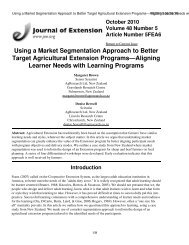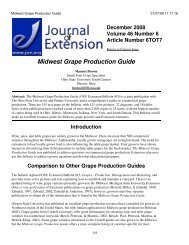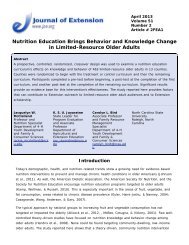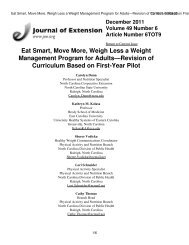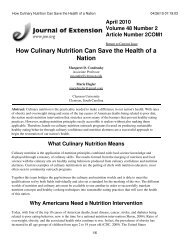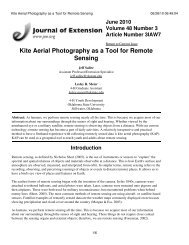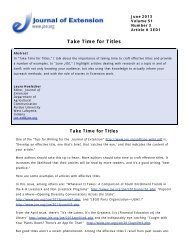An Excel-Based Mean Weighted Discrepancy Score Calculator
An Excel-Based Mean Weighted Discrepancy Score Calculator
An Excel-Based Mean Weighted Discrepancy Score Calculator
Create successful ePaper yourself
Turn your PDF publications into a flip-book with our unique Google optimized e-Paper software.
<strong>An</strong> <strong>Excel</strong>-<strong>Based</strong> <strong>Mean</strong> <strong>Weighted</strong> <strong>Discrepancy</strong> <strong>Score</strong> <strong>Calculator</strong> 04/28/11 07:07:27<br />
April 2011<br />
Volume 49 Number 2<br />
Article Number 2TOT8<br />
Return to Current Issue<br />
<strong>An</strong> <strong>Excel</strong>-<strong>Based</strong> <strong>Mean</strong> <strong>Weighted</strong> <strong>Discrepancy</strong><br />
<strong>Score</strong> <strong>Calculator</strong><br />
Billy R. McKim<br />
Project Specialist<br />
Texas AgriLife Extension Service<br />
College Station, Texas<br />
bmckim@aged.tamu.edu<br />
P. Ryan Saucier<br />
Texas State University â San Marcos<br />
San Marcos, Texas<br />
ryansaucier@txstate.edu<br />
Abstract: The Borich (1980) needs assessment model requires that a mean weighted discrepancy score be<br />
calculated for each item, competency or activity included in the needs assessment. The two most common<br />
types of Borich-type discrepancy scores noted in the agricultural education literature are importance/ability<br />
or what is/what should be. <strong>An</strong> <strong>Excel</strong>-based mean weighted discrepancy score calculator provides a simplified<br />
process of calculating mean weighted discrepancy score and reduces opportunities for user error. The<br />
<strong>Excel</strong>-based mean weighted discrepancy score calculator is a free Microsoft <strong>Excel</strong> file that allows individuals<br />
to calculate discrepancy scores for importance/ability or what is/what should be scores.<br />
Introduction<br />
Many needs assessments have been conducted to determine the in-service or training needs of agriculture<br />
educators, both in formal settings (Edwards & Briers, 1999; Garton & Chung, 1997; Layfield & Dobbins,<br />
2002; Newman & Johnson, 1994; Peake, Duncan, & Ricketts, 2007) and nonformal settings (Bowe, Smith,<br />
Massey, & Hansen, 1999; Conklin, Hook, Kelbaugh, & Nieto, 2002; Gregg & Irani, 2004; Waters & Haskell,<br />
1989). Many of those studies used the Borich (1980) needs assessment model to identify where educators'<br />
in-service or training needs existed by calculating mean weighted discrepancy scores (MWDS).<br />
Borich (1980) noted the versatility of his model that allows for modification and expansion. A discrepancy<br />
can be calculated by comparing the participants' behaviors, skills, and competencies, with the goals of the<br />
program: "a discrepancy analysis that identifies the two polar positions of what is and what should be"<br />
(Borich, 1980, p. 39). Further, a comparison could be made to determine a group of individuals' perceived<br />
level of competence to complete a task, with their desired level of competence to complete a task. The two<br />
most common types of Borich-type discrepancy scores noted in the agricultural education literature were<br />
importance/ability or what is/what should be.<br />
Using the Borich (1980) needs assessment model requires that a MWDS be calculated for each item<br />
(competency, activity, etc.). Each of the previously noted articles indicated the formula used to calculate<br />
1/3
<strong>An</strong> <strong>Excel</strong>-<strong>Based</strong> <strong>Mean</strong> <strong>Weighted</strong> <strong>Discrepancy</strong> <strong>Score</strong> <strong>Calculator</strong> 04/28/11 07:07:27<br />
MWDS; however, none of the articles indicated the specific medium used to calculate the MWDS (e.g.,<br />
SPSS, Microsoft <strong>Excel</strong>, manual calculation). Although most social scientists have access to SPSS or<br />
Microsoft <strong>Excel</strong> software, neither SPSS nor Microsoft <strong>Excel</strong> provides a menu function for calculating<br />
MWDS. Therefore, an <strong>Excel</strong>-based MWDS calculator provides simplified process of calculating MWDS and<br />
reduces opportunities for user error.<br />
Procedures<br />
The <strong>Excel</strong>-based MWDS calculator is a free Microsoft <strong>Excel</strong> file. One spreadsheet in the file can be used to<br />
calculate discrepancy scores for importance/ability, and another spreadsheet allows users to calculate what<br />
is/what should be scores. Additionally, a third sheet provides users a detailed description of each formula<br />
used to calculate the MWDSsâfor user reference or for use in describing methods. The MWDS calculator<br />
file allows users to calculate scores for up to 70 items, competencies, activities, etc., and up to 200<br />
respondents. However, the file can be expanded to accommodate a greater number of variables and<br />
respondents.<br />
Once the user has obtained a copy of the <strong>Excel</strong>-based MWDS calculator, data can either be manually entered<br />
or copied and pasted into the calculator. Calculations are automatic; the output includes discrepancy scores,<br />
weighted discrepancy scores, and the MWDS for each item. The final MWDS are displayed in a summary<br />
table that indicates the MWDS for each item and the valid n for each item (Figure 1).<br />
Figure 1.<br />
Sample View of the <strong>Mean</strong> <strong>Weighted</strong> <strong>Discrepancy</strong> <strong>Score</strong> <strong>Calculator</strong><br />
Discussion<br />
Using the <strong>Excel</strong>-based MWDS calculator expedites the process of calculating MWDS, eliminating any need<br />
to make manual calculations. Furthermore, the <strong>Excel</strong>-based MWDS calculator reduces opportunities for user<br />
error.<br />
Copies of the <strong>Excel</strong>-based MWDS calculator are free and can be obtained by contacting the authors. Future<br />
plans include making the <strong>Excel</strong>-based MWDS calculator available on the Web. The <strong>Excel</strong>-based MWDS<br />
calculator will function properly on Windows or Macintosh platform computers with Microsoft <strong>Excel</strong><br />
2/3
<strong>An</strong> <strong>Excel</strong>-<strong>Based</strong> <strong>Mean</strong> <strong>Weighted</strong> <strong>Discrepancy</strong> <strong>Score</strong> <strong>Calculator</strong> 04/28/11 07:07:27<br />
correctly installed.<br />
References<br />
Borich, G. D. (1980). A Needs Assessment Model for Conducting Follow-Up Studies. Journal of Teacher<br />
Education, 31(3), 39-42.<br />
Bowe, S., Smith, R., Massey, J., & Hansen, E. (1999). A methodology for determining Extension constituent<br />
needs: A case analysis in the forest products industry. Journal of Extension [On-line], 37(4) Article 4RIB4.<br />
Available at: http://www.joe.org/joe/1999august/rb4.php<br />
Conklin, N. L., Hook, L. L., Kelbaugh, B. J., & Nieto, R. D. (2002). Examining a professional development<br />
system: A comprehensive needs assessment approach. Journal of Extension [On-line], 40(5) Article 5FEA1.<br />
Available at: http://www.joe.org/joe/2002october/a1.php<br />
Edwards, M. C., & Briers, G. E. (1999). Assessing the inservice needs of entry-phase agriculture teachers in<br />
Texas: A discrepancy model versus direct assessment. Journal of Agricultural Education, 40(3), 40-49.<br />
Garton, B. L., & Chung, N. (1997). <strong>An</strong> assessment of the inservice needs of beginning teachers of agriculture<br />
using two assessment models. Journal of Agricultural Education, 38(3), 51-58.<br />
Gregg, J. A., & Irani, T. A. (2004). Use of information Technology by county Extension agents of the Florida<br />
Cooperative Extension Service. Journal of Extension [On-line], 42(3) Article 3RIB2. Available at:<br />
http://www.joe.org/joe/2004june/rb2.php<br />
Layfield, D. K., & Dobbins, T. R. (2002). Inservice needs and perceived competencies of South Carolina<br />
agricultural educators. Journal of Agricultural Education, 43(4), 46-55.<br />
Newman, M. E., & Johnson, D. M. (1994). Inservice education needs of teachers of pilot agriscience courses<br />
in Mississippi. Journal of Agricultural Education, 35(1), 54-60.<br />
Peake, J. B., Duncan, D. W., & Ricketts, J. C. (2007). Identifying technical content training needs of Georgia<br />
agriculture teachers. Journal of Career and Technical Education, 23(1), Retrieved from<br />
http://scholar.lib.vt.edu/ejournals/JCTE/v23n21/pdf/peake.pdf.<br />
Waters, R. G., & Haskell, L. J. (1989). Identifying staff development needs of Cooperative Extension faculty<br />
using a modified Borich needs assessment model. Journal of Agricultural Education, 30(2), 26-32.<br />
Copyright © by Extension Journal, Inc. ISSN 1077-5315. Articles appearing in the Journal become the<br />
property of the Journal. Single copies of articles may be reproduced in electronic or print form for use in<br />
educational or training activities. Inclusion of articles in other publications, electronic sources, or systematic<br />
large-scale distribution may be done only with prior electronic or written permission of the Journal Editorial<br />
Office, joe-ed@joe.org.<br />
If you have difficulties viewing or printing this page, please contact JOE Technical Support.<br />
3/3



